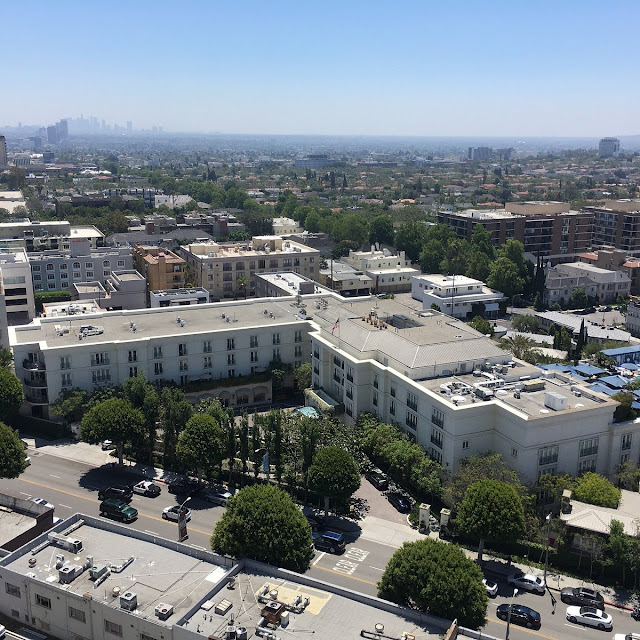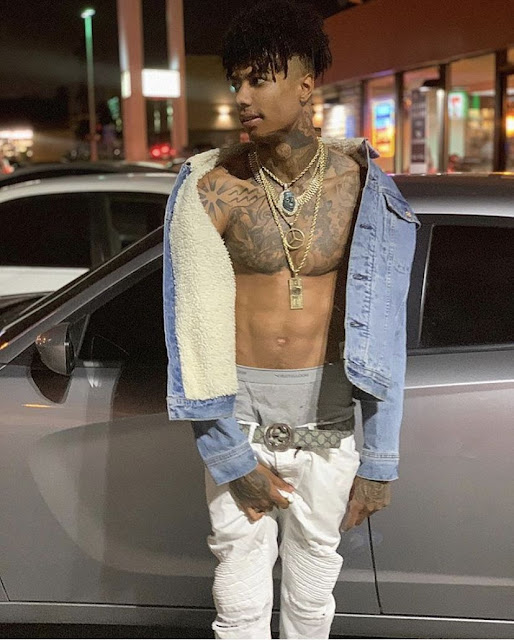Early in the morning, I pre-ordered my pumpkin/cranberry muffin (moist and tasty) and Boba tea. Sitting near the counter, I saw how gentle some Californians are. A customer (below) helped the cashier finish his order: no anger, no complaints, no shouting... just helpfulness. Serene.
I meandered towards my hotel and enjoyed the "people watching". (Sometimes, a warm climate has its advantages).
Meanwhile, my friend, Paul, drove from Orange County to meet me for a day-trip. Until then, I relied on Uber for travel, and all the cars were luxury sedans, as seen below.
My friend Paul (whom I helped move into his apartment in Astoria, NY, a year earlier), recently moved back to CA to pursue his career and evade the mistreatment that occurs at jobs in NYC. Happy to see me again, he picked me up at my hotel and took me on a "tour of Cali"!
A brief moment of "typical CA traffic", but the rest was lovely.

Passing the Century Plaza Towers (which I recall as the exterior office images from re-run TV shows like "Dynasty" and "Remington Steele")...
We rolled through a neighborhood of bungalow homes.
First, Paul took me for brunch at a restaurant named Clementine. According to the LA Eater, it is Los Angeles' best brunch place! It is a family-owned neighborhood bakery-café, and its seasonal menu uses ingredients from the local farmers' markets. EVERYTHING is "made from scratch".
Oversized pretzels caught my eye, but their variety of tarts, brownies, turnovers, cookies, and crumb cakes was amazing!

In typical "healthy CA" fashion, all the snacks are unique...
The counter-person was so happy to describe every item in the showcase, since I was a visitor from across the country. I selected the heirloom tomato (LOVE those)/fresh mozzarella salad, their zucchini pesto salad, and their piquant recipe of shredded chicken salad (which was astonishingly flavorful and well-textured, with plenty of spicy mayonnaise).
We sat outside. A bandana-wearing servers brought our iced lattes, made with Intelligentsia (shade-grown, fair-trade) coffee. Paul ordered an Italian hero--on GREAT bread--and he gave me half!
After driving through more arid hills...
...we arrived in the coastal city of Santa Monica. Until the 1760s, it was inhabited peacefully by tribes of the Tongva people. After the American conquest of California in 1848, the remaining Spaniards and Mexicans were allowed to remain, but the Native Americans were unconstitutionally diminished. The beachfront city was founded in 1875.
Paul put his car in a parking garage. What did the garage cost for an hour? Not $25+ like NYC. Only $1.20! Look how hospitable the city is... this was the Greeting Table that was in the basement garage! So inviting.
On the street was a Farmers' Market, and we sampled succulent oragnes and saw perfect peaches.
Paul confessed this is the area he'd love to live in.
We crossed the boulevard and entered the cliffside park.
It affords great ocean views with sun-splashed lawns.
Food trucks cluster together for easy access. In the background, see the Art Deco Clocktower (that's its name).
Similar to Collins Avenue of Miami, Santa Monica has many preserved Art Deco buildings enlivening its streets.
Unlike Miami, its coastline remains uncluttered. Seaside buildings are few and they're under 10-stories. That maintains the airflow and beauty of the area... something that Miami sacrificed for greedy overdevelopment.
The civic planning is as it should be. The cliffside park gives great views, while the freeway passes below. Keeping the traffic "below grade" muffles the noise and keeps it out of view. Yet, it allows drivers to see the ocean, too.
The city's pier holds restaurants, fishing spots and an amusement park!
It was my first visit to the Pacific Ocean! There are sights and activities for almost anyone.
A wooden boardwalk takes you from the cliffside park, over the freeway, to the beach and then to the pier.
What great views! So much to see!
The boardwalk has a historical marker to indicate the official end of America's world-famous Route 66.
Designed in 1926, it was instigated by America's Big Automotive Companies (but compelled to be funded by tax dollars), so that Americans avoid transcontinental trains and buy cars to drive between California and Chicago. Alas, America's Big Finance Conglomerates caused the worldwide Great Depression in 1929, so the route was used to funnel bankrupted farmers from the "Dust Bowl of America" to cities. In 1946, a postwar jazz song titled Get Your Kicks on Route 66 revived it. Alas, new freeways of 1956 caused a decline for 66. In typical American style, it was ignored and abandoned to become another "rust belt" across the USA.
Back uphill, Paul led me to a pedestrian-only shopping strip
Tidy shops, outdoor eateries, and street performers (opera, jazz, country music, poetry) kept it pretty. The trees have hanging lamps that brighten the alley at night.
The city planners allowed the alley to connect with an outdoor mall. Clean lines of traffic and good feng shui.
Even the benches are shaped like leaves/flower petals!
It must be pretty at night.
The most popular store was for Tesla electric cars, and I spotted many of them on the crowded highways.
Next, Paul took me to the Le Brea Tar Pits: in existence for tens of thousands of years. It is a national landmark. Similar to quicksand, it captured animals from prehistoric eras and preserved them as specimens and fossils.
The museum building was architecturally handsome.
Yes, the pits are a "natural wonder" but they smell like a gas station. The park's aviary was much more fun to explore.
Paul drove onward to "Little Tokyo" in Los Angeles: the largest Japantown in North America. It was established in 1905. It is a national landmark.
Above: a "wishing tree". Below: Mont-Blanc pastry with shelled chestnuts on top. (I love those).
Immigrants from the Empire of Japan made homes there until America's unconstitutional Asian Exclusion Act of 1924. That banned Asians from entering and owning property. It was done at the behest of Americans who lured Asians to do labor for their Industrial Revolution but then wanted them gone. (In 1965, the illegal law was abolished). During World War II, Japanese in America were further harmed by unconstitutional incarceration by anti-Japanese authorities. In the 1970s, Japanese banks helped revitalize the area, and it succeeds.
From the subterranean parking garage, Paul whisked me to admire the Art Deco entrance of the Hollywood Bowl.
Then, he showed me "the Valley" and LA's "urban sprawl".
He pointed the nose of the car towards Koreatown for dinner.
Formed as a non-discriminatory sanctuary for Korean immigrants in the 1960s, it is the largest Koreatown in the USA. The Kingdom of Korea began diplomatic and mercantile relations with America in 1882. Nowadays, LA's Koreatown is one of the most densely-populated parts of America, yet there is a large influx of Latino inhabitants.
Born in the USA, Paul has Korean heritage, and we both like eating Korean Barbecue meals. He took me to spiffy place named Tenraku, where we grilled our food on tabletop burners.
Thick-cut pork belly was super! The flavors were tremendous. Clinking our Korean beers together, we said "Cheers" in Korean as "Geonbae!"
Before the sunset, we entered downtown Los Angeles.
It's noteworthy of America that the tallest buildings in LA (like many cities) are all banks: Wells Fargo, Citibank, BOA, Chase.
Waiting at a traffic light, I happened to peer out my window...
and was astonished to recognize the famous Eastern Building
A marvel of Art Deco inspirational design, the mammoth edifice draws your eye upward (as if reckoning mankind's potential). See how the lobby entranceway soars--with gold sunbeams emanating!
Up to the roof, the details/colors are breathtaking.
An accurate 4-sided clock rests atop the pinnacle.
What a grand building it is... clad in blue stone! Built in 1930, it was one of the largest buildings in the United States.
It took only 9 months to build... which is amazing, considering how long it takes contractors to remodel a house nowadays! What a pride-worthy structure it is to behold.
LA has several Art Deco sky scrapers.
Its Train Station looks churchly, if you consider the arch, round window and bell tower.
The building below illustrates the importance of architectural details and some ornamentation. It tries to resemble NYC's Plaza Hotel, but without the details/patterns, it is bland.
Compared to the original, it proves that life needs details and artistry to be alive.
We also saw guys acting illegally as prostitutes, waiting for a driver to pause and "pick them up".
After 106 years of being a punishable crime, prostitution remains prevalent in Cali, and it was the basis for the world-famous Hollywood film, Pretty Woman. However, in the 1850s, America's capital was awash in legal prostitution, with a cluster of brothels on Pennsylvania Avenue, near the White House.
In the evening, Paul exited the sluggishly congested expressway to refuel at a gas station. I discovered that bi-curious men and closeted guys "cruise" gas stations to tempt gay guys. Many men immigrate from countries where prostitution is legal, and they are frustrated by America's laws against it. America's stigma against homosexuality causes "straight-acting" citizens to hook-up for random quickies. To avoid America's ongoing homophobia and gay-bashing, guys invented a secret signal system for "casual fun".
To conclude our evening, Paul took me to a dessert bar called Syrup.
I tried their homemade ice cream: Dutch chocolate, Viennese coffee, and blueberry/lavender. Great!
I was very grateful to Paul. He replied that he still remembered the Walking Tour that I gave him in Astoria, NYC, and my detailed exuberance made him decide to relocate there from overpriced Manhattan! Wow. (You never know how your actions impact someone, so do good ones). To see the type of Walking Tour that I gave him, please use this link: https://halfwindsorfullthrottle.blogspot.com/2015/06/walking-tour-streets-food-architecture.html
I arrived back at my hotel in time to admire the sunset. I went to bed to recharge for my homeward flight, the next day.
A funny coincidence was that, upon my return to NYC, I landed in time to admire the beginning of another sunset (Eastern Standard Time again) and the promise of a new adventure.
















































































































The food looks amazing!!
ReplyDelete